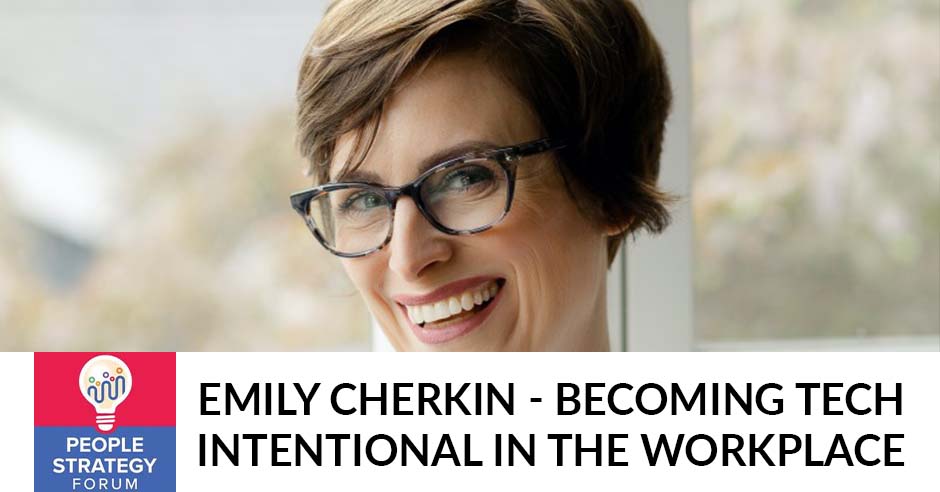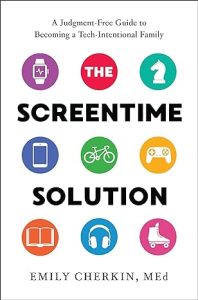Emily Cherkin – Becoming Tech Intentional In The Workplace

Technological innovations have found their way into almost all aspects of our personal and professional lives. However, society seems to be overusing and misusing them, which has led to an unhealthy amount of screen time for both children and adults. In this episode, the People Strategy Forum chats with Emily Cherkin, the Screentime Consultant. She explains how to make the education system and workplaces more tech intentional to avoid becoming overly dependent on digital solutions. She also shares various tips on using technology more responsibly and why it is essential to reconnect with the real world.
—
Emily Cherkin – Becoming Tech Intentional In The Workplace
I want to make sure that we’re introducing you to our hosts overall. We have Sumit Singla. He is a seasoned people strategist broadcasting out of India. We’re fortunate to have him. We have Char Miller. She is in Puerto Vallarta. She is getting ready to pack up to come back to the US. Goodbye sunshine, and back to the early spring weather. Thanks for joining.
In this session, we have a special guest. We’re going to be talking about becoming tech-intentional in the workplace, which focuses on a very timely challenge of managing our digital consumption effectively. We are delighted to have Emily Cherkin. She’s also known as a screen time consultant to share her insights.
Looking Back
Emily is a former middle school teacher and has transformed her firsthand experiences with the digital evolution in education into a crusade on an international scale. You’re getting ready to talk in Portugal. The approaches that Emily is going to be talking about are important not only for parents and educators but also for leaders and people in their businesses to make sure that we have those healthier digital habits that can impact all of us. It’s an important topic. Let’s start with Emily and learn about you, your past experiences, what brought you into this world, and how you help your people.
Thank you for having me. I’m honored to be here. I love talking about this work. I am a former middle school English teacher. I spent several years working with middle school students. First, it was seventh-grade English, and I shifted to more of a social skills media literacy program when I went part-time. One of the things I witnessed in those several years in the classroom was this change over from kids having no smartphone at all, but not even flip phones, by the time I left, several years later, 95% of my students had smartphones, and social media was all the rage. In my earlier teaching days, it was Facebook. There are no teenagers on Facebook now. That’s all new platforms for young people.
It woke me up to the fact that it wouldn’t matter what my vocabulary lesson of the day was if the kids were talking about how they got left out of something over the weekend that they saw on Facebook or why they made this group that said they hated them. I was like, “We have to talk about this. This was affecting the social dynamic of student life at school.” That was in 2013.
When I started talking to my students, they said, “It’s our parents who are scrolling when they’re bored. It’s our parents who are texting and driving.” This isn’t a kid problem. That was my a-ha moment. I was like, “This is an adult problem impacting children. I need to help adults as an extension of that will help children.”
I launched my business in 2019. I’ve been busy working with parents, schools, families, organizations, and anyone adjacent to parenting or children, which is everybody in some way. My approach is what I call tech-intentional, and the TLDR of that is less is more, later is better, and relationships first. That’s true for all of us when it comes to digital tech.
Digital Trends
Let’s dive in if you wouldn’t mind, Emily. You covered some high-level experiences that you saw in the classroom. We’re looking at statistics and what the world is seeing now. Are there other trends or complications that you’re witnessing as far as digital usage in the classroom?
I always try to explain this as at least a two-part problem, and it’s more complicated than that. I’m simplifying somewhat. The challenge is that children have personal devices at younger and younger ages. Thirty percent of eight-year-olds have smartphones. This number has gone way down. The other problem is that we have digital tech in the classroom at unprecedented levels. In my early teaching days, we had STEM, steam, and all of this very pro-tech 21st-century skill training in my professional development work.
I always say, “I am not anti-tech. I am tech-intentional.” The problem to me is that the pendulum has swung way too far in terms of technology and negatively impacts teaching, learning, and relationships. You add on the chaos of the pandemic. That was a time when tech served an important purpose in that spring of 2020 for children to stay connected to teachers.

Tech Intentional: The pendulum of technology has swung way too far that it is now negatively impacting teaching methods and personal relationships.
You have the home front where it used to be parents were worried about screen time at home. How do I manage that? What we’re finding is kids are having 4 or 5 hours a day on a digital device at school. We’re talking cumulatively for 5 to 9 to even more hours, depending on the age of the child, on a digital device. People will say, “Where’s the data? Where’s the research?” I’m a big fan of research, but in my mind, as a parent, a teacher, and someone with this common sense, I don’t think anybody would say that’s a healthy amount for anyone, let alone a child with a developing brain.
There are these two-part problems. We’re hearing a lot about anxiety, mental health, and youth challenges that are real and connected to digital media. They’re not exclusively because of it, but it’s connected. That is having an impact on all these other things. It’s a complicated problem. I believe strongly that we all play a part in finding a solution.
Workplace Environment
Char, you often speak about the old days when you had the Blackberry and the executive suite. Back then, you would see a lot of leaders walking around and typing on their phones. How do you think that’s changed now, Char, in the workplace environment? Do you still see certain distractions in the workplace that are similar to what Emily’s looking at with the students?
I was talking to a former employee who works in engineering for Intel. I had a conversation with him about all the different changes from a technological standpoint. I was talking to another gentleman from IT. The other gentleman’s name is Sean. Let me tell you what Sean’s background is. He is an IT professional in healthcare, which is near and dear to my heart. I was asking him, “When an employee is working, how do they track how you’re working? Is your mouse moving all the time? If your mouse is stagnant, that might mean that you went out to let the dog outside and keep track of every clique.
We were boring the other people at the table because I was fascinated about this. Apparently, technology can monitor your productivity and what you’re working on. In other countries, they monitor your eye movements to ensure that you’re paying attention. In a way, that made me self-conscious because when you’re sitting in a cubicle or an office, and you have constant interruptions, and you’re having a cup of coffee with your coworkers, but yet you’re on the computer all day, you did not have that monitoring that all the technology now has.
My mind goes to where it crosses the line. In my world, I did support departments like the coding department and physician billing departments. I had a lot of interesting dialogues with managers who had struggles with productivity and taking and assuring their employees were assuring an outcome on a daily basis. The technology is monitoring every day. In my view, that can be exhausting. It’s like Big Brother being constantly watched and fatigued. From a student perspective, that has to be challenging. I’ve had two big conversations about this topic.
The first thing I thought of when you were talking about the mouse not moving was, “That’s our thinking time.” We’re not leaving time to contemplate or wonder. As a teacher and somebody who knows a lot about children and development, that’s mind-boggling. We have to leave time for that.
I asked him, Emily, about that question. You and I should have been at this dinner. I said, “If I’m reading an article on my screen and I’m reviewing my report, I know students are constantly moving their screens around and looking, but I need time to read the screen. It’s not as easy as opening up my textbook, sitting on my couch, reading my textbook, and highlighting things.”
What he said is that his IT department does this. They monitor every time you’re rolling your screen up and down to assure that you’re truly reading. They’re monitoring your screen for the amount of time it would take for you to read a page and how slowly you’re moving your screen up and down. Emily, I’m the story girl. I always have real-life stories. Even in Puerto Vallarta, isn’t that fascinating? What do you think about that monitoring? It blew my brain. This isn’t a current healthcare system. None of those that I work for.
I’m glad to hear that articulated as an example. I took my daughter to a doctor’s appointment. The doctor was telling me that in the medical profession, there’s a huge pressure to use AI for charting. The way it would work is that the AI would listen in on your doctor’s appointment and chart based on keywords that it hears when you have a conversation. This will change how I speak to my doctor, which is not a great thing in terms of healthcare.
Children are different from adults. Adults theoretically have fully formed brains, although not until we’re in our late twenties when they are fully formed. We still are vulnerable and susceptible to a lot of these persuasive elements. We still accept that we’re getting, “Google knows everything I’m doing anyway. What’s the big deal?” You break it down to these examples, and it’s like, “What is that setting us up for?”
Despite adults having theoretically fully formed brains, they are still vulnerable and susceptible to various persuasive elements. Share on XThe word surveillance gets this like a scary word, but it erodes trust. Whether that’s you and your doctor, you and your employer, or you and your child, this is one of the challenges I have with parental controls. It’s not that they can’t be one tool, but parents want that to be the magic solution. It’s not. That worries me. What are we setting ourselves up as a universe or a global community when we are comfortable with that level of surveillance and do not know where that data goes? That’s another terrifying factor.
I’ll make one more comment because it is like Sumit’s view on this. They used to provide us, in our olden days, recess. Recess was the time we could exercise and do all of our jumping on the bars. When we came back to the classroom, we could have that social interaction and make fun of each other because of what clothes we were wearing. What I’m saying is that you don’t get recess. You get an hour for lunch, but you are measured. Sumit has some thoughts. What do you think, Sumit, about all this technology? You’re a technology wizard.
Educational Impact
I’m a huge fan of technology. It’s taking away a lot of our skills in some ways. One of my favorite examples is that, and I don’t know if it’s still true or not, but apparently if you want a taxi driver’s license in the city of London, you need to know all the streets and all the lanes by heart. You can’t be using Google Maps. A lot of people are arguing against it, saying, “It’s outdated. It doesn’t make sense in the current world.” It is likely to be true, but they’ve stuck to it based on the tradition. The taxi drivers themselves are unhappy because Uber drivers can use the map. They can get you to your destination faster and often cheaper. That’s a use case for the adoption of technology.
As a parent of a six-year-old child, I’ve seen what the pandemic has done in terms of education behind a screen. It has added a lot more challenges because of the early exposure to tech. We’ve consciously tried to be a family that doesn’t allow cellphones or digital devices at the dinner table. We also try to limit screen time.
The simple things like her dentist said, “You need to brush for three minutes.” How long are three minutes? Alexa set a timer for three minutes. If she’s traveling, she would refuse to brush without a time off. I have to double up as a timer, where I make funny alarm sounds to get us started and get her to finish. That’s how technology is becoming part of life. We try, and we win a little bit of the analog experience. Simple things like she knows how to operate a phone and how you can click a picture of a bird when we are out on a walk and use AI. The point is you don’t learn enough, in my opinion, if you do that.
The idea is to make it a multi-step process where you do a reverse search to figure out the name of the bird. You use another piece of technology to understand where the bird lives and where the bird originates. What is the sound that the bird makes? You create a scrapbook entry about the bird saying, “Spotted here on this day.” That’s a better way of embedding that learning than that passive hit of like, “I searched and found the name of the word. Tomorrow, I’ll forget all about this and move on.” I’d love to hear Emily’s views on this.
I love that I think what you’re describing is what I would call a very tech-intentional use of technology. You referenced skills are not happening. I used the phrase skills before screens. I’ll give you one example. Several years ago, I was working with a sixth-grade student. Her school had a one-to-one program. In the US, that means one device per child. In this case, she brought it back and forth to school, and it was an iPad. The curriculum was entirely digital.
Char, you mentioned flipping through a textbook. Those don’t exist anymore. When schools buy curriculum, they’re all digital. There is no physical book. There are many problems with that because there are many benefits to reading a tactile, three-dimensional book. Occupational therapists are telling me that children are having trouble learning how to turn the pages of a physical book. They are young children because they’ve never done it. What they’re working on in therapy now is physical pages.
This child I was working with had a homework assignment. She had to open her science textbook. She had to scan through a chapter to find the answer. She opened a different app to type the answers. She cut and pasted the question into a Google search bar. We know that friction is what makes us learn and when there’s something hard that we have to struggle through. Google is the opposite. It’s fast and easy. Any child is quite smartly going to pick the easy option. Adults do this.

Tech Intentional: Friction makes us learn. We grow when going through hard times. Google is the opposite. It is so fast and easy.
She types it in or cuts and pastes it. She doesn’t even type it. She gets the search back, cuts, and pastes that into the homework assignment. I’m like, “Do you know what plagiarism is? Have you thought about at least putting this in your own words?” She says, “I don’t know how to type.” My mind was like, “Why do you have an iPad for school?”
That’s an example of why the skills have to be there first. I want tech labs to be back in schools. They’re gone because every kid has their own device. I want there to be a couple of times a week a typing class, a media literacy class, a class on how to research, and an understanding of missing disinformation. Those are critical skills in a digital future, whether you’re a child or an adult. We’re not doing that. We’re giving them all the tech and hoping they’ll turn out over.
Emily, I have to ask this now because we also know that we’ve lost the art of cursive. I see across my street and my social media platforms that the older generation now has a way to send encryption messaging to each other by writing cursive because nobody is going to understand what we’re saying.
The kids can’t read historical documents.
That’s the strategy if we want to communicate. It’s scary. I practice cursive so I can remember how to write. My handwriting sucks these days.
That becomes an interesting problem in a growing country like India because we tend to believe that we need to do everything like the developed nations do. A lot of schools have gotten into this habit. We need to be seen as more advanced and progressive. It doesn’t matter if you’re in grade one. Everyone must bring an iPad to school. Some of the fancier schools try to do this.
When we were searching for a school for our daughter, we consciously stayed away from the overuse of tech, where you are experiencing the world through a screen. You’re far away from the sights, sounds, and smells of the real world. It’s more important to know what mud is and play and hop in a puddle than to read about it or watch a video of a party that can get too wet or mud tends to stick to your clothes. It’s interesting. Parents are on both ends of the spectrum. There are some parents in my daughter’s school who believe the school isn’t adopting tech fast enough. Unless we start training kids on AI, they’re not going to have a future. I’m like, “No, keep them away from ChatGPT. Let them think for a while.”
All we have to do is look at where the big tech executives send their children to school. It’s Waldorf Nature-based screen-free schools. They know that it’s not best for children. That makes me angry when that’s the message, and it is a powerful example of global pressure.
Online Addiction
I love what you’re doing there, Emily, because you’re bringing awareness that there needs to be education around the proper use of technology, especially for children. We’ve unleashed this upon the community without thinking about its long-term impact. We’ve found that there’s been a lot of online addiction early on. It’s not just addiction but also influence. What is your perspective as far as ways that we can teach our children responsible use to stay away from being addicted to their phones and the content that they find on there?
You’re right that the education component is necessary both for ourselves as adults and for how we teach our children. I believe strongly that we can teach our children that these products are designed to hold our attention. When you’re arguing with your kid about giving up an iPad or turning off a phone, it’s not you versus your child. It’s you versus a hijacked neural pathway. It’s not a fair fight. It’s dopamine. You’re never going to beat that. Sumit with your 6-year-old, you can use language. Your brain likes this. Your brain wants you to keep playing. You can say, “It’s not what your brain is not telling you the right thing. It’s being tricked.” Kids get passionate when they’re like, “What?” They don’t like being tricked.

Tech Intentional: When arguing with your kids about their mobile devices, it is not you versus your child. It is a battle between the parent and a hijacked neural pathway.
My favorite strategy to give to anyone, parent or non-parent, is this idea of living your life out loud. That’s narrating what you do. You can do it anytime it comes to digital tech. You can do it with non-tech stuff. I’m reaching for my phone. I’m going to check and see what time I go to work. I looked at Google Maps, and I knew how to get there. I’m going to find out if the weather is going to be rainy. I’m looking at my texts, and now I’m bored.
This is the stream of consciousness, which is annoying, but that’s the point. You want to bring awareness to it for yourself and also for the people around you. What I find powerful is we’re accustomed to people doing this. Being in the middle of a conversation. Their eyes drop, and we’ve lost them. Phone plus snubbing is what that’s called.
Children hate that, but so do adults. None of us like that feeling of, like, “I was in the middle of talking to you. I stopped talking now. I wait.” Part of it is we aren’t even aware we do it. If we’re narrating it and I’m in the middle of a conversation, I say, “I’m sorry. I got a text. Excuse me, one moment.” At least there’s an acknowledgment.
We want to do that because that’s what we want our children to do. We want them to say, “I’m going to go and turn on the iPad because I want to watch a show. Is that okay?” Depending on the age and your family’s values. What you’ll notice when you start doing this is how few people do it and how rude it feels when they don’t. It’s an easy-to-do strategy that has a big effect in any environment. We should all start doing that.
I 100% agree, not that I’m dating and I’m not planning to be dating, but sometimes, those funny little articles come up, particularly in the dating world. If you’re on a first date and your date is constantly doing this, you need to stop, look at them, wait until they’re done about two minutes later, and say, “Have you finished your discussion there? Let’s talk about what we were talking about.”
Experiencing The Real World
May I make one other comment? I was raised by a biologist. I was raised in nature, around wildlife, and hiking. I had a teddy bear in my backpack. When it comes to experiential learning, where does that go? Sometimes, it’s good to go out. When we talked about the bird and what Sumit was talking about, wasn’t it good to physically look at the bird? We have a recording of a bird that describes the markings.
I love hummingbirds. I look at my hummingbird every day. His name’s Twitter. Twitter and I are best friends. When I’m talking to Twitter, he doesn’t understand what I’m saying, but at least I’m watching his behavior and the number of times he is drinking the nectar, as long as I’ve fed the hummingbird feeder, and when he thinks that the nectar is not good. To a child, that’s interesting.
My dad did send me a link of all the different hummingbirds in the world. I could read about all the hummingbirds. However, it’s good to physically go out and look at them. You went to the botanical gardens. The CompTeam did that, which was a wonderful experience. We have to learn about all the different wildlife. What are your thoughts about experiencing the world? You can learn about math when you talk about the tides of the oceans.
It doesn’t have to be an either-or. It’s the order of operations to use a mathematical concept. If we have kids wanting to look up more information about birds online, it’s fine, but start in the real world first and use the tech as a tool to come back and get more information. I remember, as a kid, we had encyclopedias on the shelf. If we’d talk about something, he’d go, pull the book off the shelf, open it up, and read about whatever topic we were talking about. That was impactful.
That’s a strategy I feel like for parents. We turn quickly to Google because it’s there. I would love to have us reach for a book or even a phone call to call someone who might know. Phone a friend, and anytime we can model tech choices intentionally. We might not be able to hear a recording of a bird in a book, but could we read about the book? Could we go to the library? Could we call the bird association and ask questions?
We quickly turn to Google because it is readily available. Whenever you can, reach for a book or call an actual person for help. Share on XThere are many skills embedded in that curiosity and way of learning. Experiential learning is critical. You mentioned recess was an hour. It’s twenty minutes now if you get it. The problem is we’re cutting recess, arts, and nature. They might get PE, but only half a year of it. That is all the physical exercise kids get. We know kids are much less physically active now, in part because of the passive screen consumption. It’s a multifaceted problem that needs multiple solutions. Anytime we can prioritize that hands-on tactile real-world learning, I am 100% in agreement with you.
We talk a lot about physical fitness, nutrition, and all the things to keep ourselves healthy. As a mother who struggled with Diet Coke in the refrigerator and the package of Oreos, and I don’t mean to go down that path, how about offering a cooking class where we can learn vegan cooking like some of us on this panel or have a cooking class where we could not home ec. I’m not talking about home ec, where we burn the cookies in the oven. I’m talking about learning about different countries and learning that. I also saw articles about finance classes. How do you do your taxes? How do you change a tire? I’m with you there, Emily. We needed those skills. Where were those skills when I was a kid?
The problem is that technologists come at that response with a tech-based solution. There are times when that might be a great option, but not for everything. The problem I’m seeing in education is why we are letting technologists dictate what children are learning in school. They’re not experts in children. They’re experts in technology.
We’re sliding backward. We always talked about less screen time for our children. I think about the statistics of the number of times our children are in front of a screen. What are the statistics on the amount of time children at school are on a screen nowadays?
It varies heavily. It might be 30 minutes or 6 hours. It could be that for a kindergartner or a fifteen-year-old. It depends on the school, school, the policy, and the amount of tech in the school. My belief is that it’s all too much for the most part. That less is more. A little bit is okay. A lot is not good. I’m afraid it is going backward. This was a rising challenge prior to the pandemic. The pandemic added fuel to the fire. It was an opportunity for a lot of companies to say, “We got a solution.” Independent research has found that schools in the US average about 125 unique platforms per school. There’s no way you can supervise, monitor, and know what kids are doing.
Another anecdote. I went to my daughter’s school. She’s twelve. It’s a middle school. It’s a phone-free school. I will say that that is 100% the right policy approach for education. Kids should not bring devices to school. It’s a loosely defined and enforced policy. It needs to be away from your person in the locker from first to last. What happens is that kids put it in their pockets and sneak it. It’s better than nothing. It’s good to have a policy, but at this school, these kids have laptops for school. I walked into the auditorium during a choir festival, and there were three boys sitting on their school-issued computers playing video games. They have a phone. They have computers.
Making schools phone-free is perhaps the right policy approach for education. Share on XThat was the computers provided by the school. I thought there were limitations on that.
I call this digital whack-a-mole. You try to block one thing. I spoke to a family. Their child downloaded a VPN. Sumit, you know way more about this than I do, but he’s been watching YouTube at school. Even though YouTube is blocked, he can access it because he downloaded it.
Responsible Use
The bottom line is that our children will find a way. That double underlines the reason why it’s important for us to teach responsibility, discretion, and the appropriate use of technology overall. One thing I’d like to dive into more is we’ve spoken about the way that technology can be addictive. We’re finding that it can be highly influential in creating certain thoughts and behaviors in both a positive and negative way. We can use it to reinforce habits. We can be influenced by using social media and becoming polarized. Are there any movements in schools about responsible usage? Do you see that this being at least bringing more awareness?
I am sure that such programs exist in some schools. I don’t necessarily see a cohesive national approach to that in part because I think there’s a message that if we do that, we’re contradicting ourselves by providing all this tech in the first place. We don’t want to make ourselves look hypocritical, which isn’t an excuse. It’s all the more reason to do something like that. That’s a good question.
The other piece of this is we have to be thoughtful about who the responsible party is here because it is easy and convenient to blame parents for this. The technology industry loves it when we blame parents because it’s not their fault. I always say it is not our fault as parents that this problem exists, and people may push back on it, but it is our responsibility to address it.
I don’t think parents gave phones out, knowing where we were going to be now. The screens for school problems made it harder and worse. You might have had great rules at home about phone use and device use, but the school is sending home iPads or Chromebooks. What are you supposed to do? You’re supposed to say, “Our rule is no, but my kid is saying he has got to do this for homework.” We have this contradictory messaging coming from the schools.
I’m not letting parents off the hook. I don’t want to say that parents don’t have a role to play, but they’re an easy scapegoat for a problem that is much bigger than a parenting problem. Sumit, you made this point that at your child’s school, there’s a big range of parents. I hear this, too. Parents who want no tech and parents who think we’re crazy for not doing more tech. We have to educate both ends of that spectrum about what I think is intentional tech.
One thing you mentioned, Emily, is that the pandemic further perpetuates isolation. When we’re thinking about this in the workplace, the misuse of technology has been rampant for a long time. Think about going into a meeting or you’re walking down the hall, and we’re supposed to be interacting with one another or discussing things collaboratively.
We find people that are stuck to their phones. They are answering texts instead of interacting. When we talk about awareness overall, that’s the whole purpose of this conversation and having this episode on this topic. Is there a way or strategy that you can think of to encourage our awareness throughout the day on proper use of technology?
In particular, the workplace environment. Is that what you’re thinking?
As adults, we need to be reminded. We hear the ding on our phones. We could be talking to somebody, but we’re pulling up the phone to see what it is.
There are multiple answers. One of them is certainly, in a work environment, creating a culture where being tech-intentional is the norm, not the exception. That’s going to have to be a leadership responsibility in defining what that looks like and how you help your people and yourself, having to role model it, like with a parent and a child. Parents who are constantly scrolling are showing their children that that’s okay. What people do is what we do.
There are some practical, technical solutions to this or part solutions. One is to turn off all your notifications. That’s something I’ve done for years. I’ve never missed a text message because I’m surrounded by computers, phones, and laptops. The reality is what it takes away is the ding that interrupts, because that interruption is allowing someone who is not even in the room. It’s giving them permission to interrupt something. They’re not even physically here. That’s rude as an adult conversation, but think again about a child’s perspective.
Turn it off. I promise. You’re not going to miss much. It’s going to come back. You’re going to have your phone in your hand nearby. That’s the solution. We can do things like turn our phones to grayscale, which makes it a much more unpleasant visual experience. It will decrease our desire to spend time on it. I deleted social media apps for a long time. I ended up having to put Instagram back on, which I don’t love. It was funny. I was doing a Facebook Live with someone. I had to re-download Facebook on my phone. It hasn’t been there in years.
There are simple, intentional things we can do to make them. Add the friction to go back to making it harder for us to access or use. The low-hanging fruit here is to get phones out of the bedroom. The number of adults who have phones in their bedroom and scroll at night before bed is in the high 90 percentile. It’s a simple move. It could be on the other side of your room. You have to physically get up to get it. All of these are small little changes that can add up.
I have a thought, Emily. This is where my mind’s going because, as an HR person and talking about the advancement of technology back in the BlackBerry days, the challenge is that, as we well know in the compensation world and talent workforce shortages, particularly in the high tech space, and as you can already tell, I 100% agree that we need to shift. These are the positions that are in high demand. How do you balance the fact that we need to educate in the high-tech world?
Every single minute of the day, something new is coming out. Every time you look at all your stuff, something new is coming out, including AI, for example. How do we help our youth keep up with the technology demand for careers in the future while balancing that it’s not that healthy? What are your thoughts on that?
I get this a lot in a slightly different version, which is like, my kids need this to be successful in the future. When I was in second grade, my computer lab skills were focused on the organ trail game. I don’t use those technological skills now. I am not suggesting that we don’t expose children to some cool parts of technology. There are amazing things with graphics, music, and multimedia. Even coding, you can introduce it as part of a curriculum as one element. That is different than giving kindergarteners iPads for reading skills, where there’s no pedagogical reason or scientific evidence that says kids learn to read better on an iPad.
We have to differentiate what the skills are because I’m going to guess that any of those high-tech executives have to have other skills like communication, eye contact, problem-solving, and critical thinking. None of that is going to be because they started tech earlier. If anything, it’s the opposite. Like you, they had nature-based childhoods where they were allowed to wonder and be curious about problems and solutions, or Sumit’s point about minimizing tech at a young age. That is a misnomer. We are fooling ourselves if we think that they have to have it younger to be successful later.
Adults who go to graduate school to learn engineering and coding don’t have those skills in elementary school. They learn it in graduate school. Tech is easy. I’m not saying I know all about it, but it’s easy relative to other skills to learn and adapt because it has become embedded. I respectfully push back on that notion a bit, and I would encourage executives and HR to focus on the skills that make you a good employee, partner, and colleague. Thank you.
Episode Wrap-Up
Thank you, Emily. You have a lot of things going on. For our readers who want to know more about this approach and how they can be more tech-intentional, not only with their children but also with their workforce overall, what would you recommend for them?
I write a lot about this topic, and I did come out with a book. If that is of interest, it’s called The Screentime Solution: A Judgment-Free Guide to Becoming a Tech-Intentional Family. There’s something in here for everyone. I called it The Solution because we’ve got a lot of books about the problem. I wanted to focus on tactical things we could do. I write weekly essays. There’s a mailing list on my website. That’s a great place to sign up and get weekly content. I try to stay on top of whatever current hot topic tech issues are happening. A lot of it is around tech, schools, and education. My website is TheScreentimeConsultant.com.
I am on social media platforms. I know the irony of saying that I have a team of people who help me with my posts, but I am on Instagram, LinkedIn, Facebook, and Twitter. I don’t post a bunch on Twitter. That’s where you can find me. I appreciate this conversation and hearing Char and Sumit’s perspectives. It’s wonderful and quite a rich conversation. I’m grateful for this opportunity.
Thank you so much, Emily, for your wisdom and for sharing it here on the forum with us.
Thank you for having me.
Thank you, Emily. It’s a pleasure to meet you. I’ll watch for you and your book. It sounds outstanding.
Thank you, everyone, for tuning into the People Strategy Forum. We’ll see you next episode.
Important Links
- Emily Cherkin – LinkedIn
- The Screentime Solution: A Judgment-Free Guide to Becoming a Tech-Intentional Family
- TheScreentimeConsultant.com
- Instagram – Emily Cherkin
- Facebook – Emily Cherkin
- Twitter – Emily Cherkin
About Emily Cherkin
 Emily began her career as a middle school classroom teacher in 2003, where she witnessed the rapid evolution of technology in education—from dumb phones to smartphones and social media, and the implementation of online grade books, learning management systems, and 1:1 device programs. As a parent, Emily experienced firsthand the challenges of managing screentime, with her son adeptly navigating an iPhone, her husband distracted by Slack, and herself immersed in endless social media feeds.
Emily began her career as a middle school classroom teacher in 2003, where she witnessed the rapid evolution of technology in education—from dumb phones to smartphones and social media, and the implementation of online grade books, learning management systems, and 1:1 device programs. As a parent, Emily experienced firsthand the challenges of managing screentime, with her son adeptly navigating an iPhone, her husband distracted by Slack, and herself immersed in endless social media feeds.
The COVID-19 pandemic intensified these challenges, turning technology from a useful tool into a source of constant consumption, distraction, and disconnection. Remote learning, working from home, and online socializing became the norm, revealing the inadequacies of our tech usage.
Determined to find better solutions, Emily now dedicates her work as a speaker, consultant, and parent educator to providing tech-intentional™ solutions. She helps parents navigate the emotional battles of screentime, offering strategies to ease these challenges without relying on more tech-based fixes. Emily’s unique perspective and firsthand experiences make her a valuable resource for parents feeling overwhelmed by the digital age.




